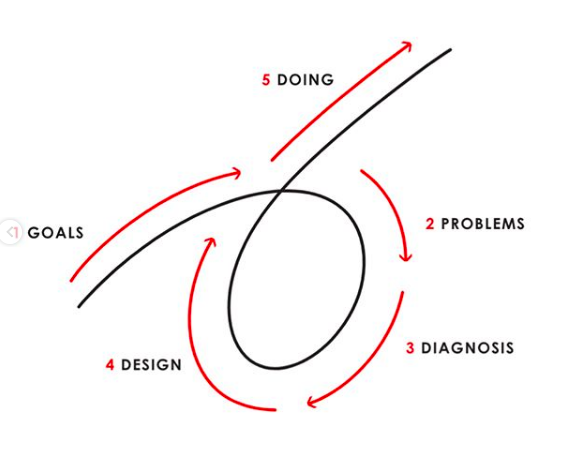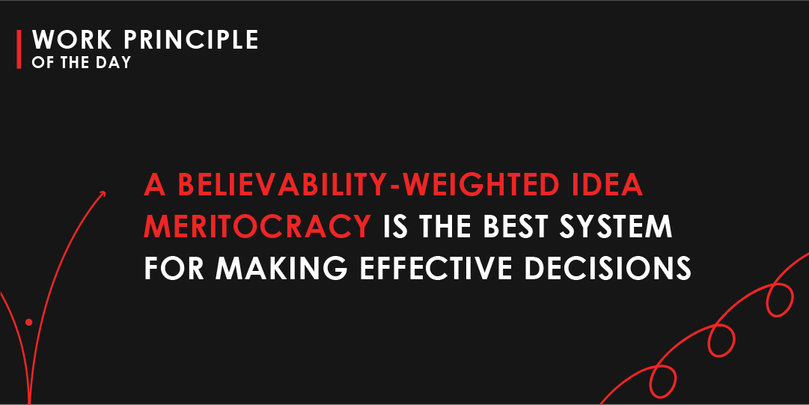?Principles? is the latest book by Ray Dalio ? founder of Bridgewater, the world?s largest hedge fund. In this rather hefty tome of a book, Dalio offers an insight into the principles which he?s applied throughout his life and work, and his underlying reflections. He kicks off the book by explaining that ?Good principles are effective ways of dealing with reality? and that ?To learn my own, I spend a lot of time reflecting.?

?Principles? consists of three parts. In the first part, titled ?Where I? coming from?, Dalio looks back on his career and the founding of Bridgewater. ?Life Principles? is the name of the second part, and covers Dalio?s approach to life?s challenges and opportunities. Finally. part three covers Dalio?s ?Work Principles?. Let me share the key things I?ve taken away from ?Principles?, starting with Dalio?s Life Principles:
- Embrace reality and deal with it ? Dalio shares an important equation which in his view makes for a successful life: Dreams + Reality + Determination = A Successful Life. For the ?reality? component of this equation to work, Dalio encourages his readers to be radically open minded and radically transparent.
- Pain + Reflection = Progress ? Dalio?s point about ?going to the pain rather than avoiding it? resonated with me (see Fig. 1 below). It?s easy to dismiss this statement because it?s coming from a highly successful investor, but I?d flip that as I can see how someone like Dalio has gone through his own share of pain to get to where?s he gotten to, and learned along the way.
- Using the 5-step process to get what you want out of life ? Start with having clear goals (step 1), followed by identifying but not tolerating the problems that stand in the way of your achieving those goals (step 2), then you accurately diagnose the problems to get at their root causes (step 3), design plans that will get you around them (step 4) and, finally, do what?s necessary to push these designs through to results (step 5). Dalio depicts this as a continuous process and people can benefit from applying this model to achieve their goals (see Fig. 2 below).
- Understand that people are wired very differently ? Dalio stresses the fact that all people are wired very differently, and zooms in on the differences between left and right brained thinking (see Fig. 3?4 below).
Fig. 1 ? Going to the pain instead of avoiding it ? Taken from: Ray Dalio ? Principles, p. 154
- Identifying, accepting, and learning how to deal with your weaknesses.
- Preferring that the people around you be honest with you rather than keep their negative thoughts about you to themselves.
- Being yourself rather than having to be strong where you are weak.
Fig. 2 ? Ray Dalio?s 5-step process ? Taken from: Ray Dalio ? Principles, p. 171

Fig. 3 ? Differences between left and right brain ? Taken from: https://visme.co/blog/left-brain-right-brain-marketing/

Fig. 4 ? Understand the differences between right-brained and left-brained thinking ? Taken from: Ray Dalio ? Principles, p. 223
- The left hemisphere reasons sequentially, analyses details, and excels at linear analysis. ?Left-brained? or ?linear? thinkers who are analytically strong are often called ?bright.?
- The right hemisphere thinks across categories, recognises themes, and synthesises the big picture. ?Right-brained? or ?lateral? thinkers with more street smart are often called ?smart.?
Dalio?s Work Principles are dominated by the concept of an Idea Meritocracy ? i.e. a system that brings together smart, independent thinkers and has them productively disagree to come up with the best possible collective thinking and resolve their disagreements in a believability-weighted way (see Fig. 5 below). Dalio successfully implemented an Idea Meritocracy at Bridgewater and shares the components of such a system in his book:
Idea Meritocracy = Radical Truth + Radical Transparency + Believability ? Weighted Decision Making
- Radical Truth ? Talking openly about our issues and have paths for working through them.
- Radical Transparency ? Giving everyone the ability to see everything. Radical transparency reduces harmful office politics and the risks of bad behaviour because bad behaviour is more likely to take place behind closed doors than out in the open.
- Believability ? Dalio defines believable people ?as those who have repeatedly and successfully accomplished the thing in question ? who have a strong track record with at least three successes ? and have great explanations of their approach when probed.?
- Thoughtful Disagreement ? The concept of Believability is closely linked to the art of Thoughtful Disagreement; the process of having a quality back-and-forth in an openminded and assertive way to see things through each other?s eyes.
- Weighted Decision Making ? At Bridgewater, employees have different believability weightings for different qualities, like expertise in a particular subject, creativity, ability to synthesise, etc. Dalio explains that in order to have a true Idea Meritocracy one needs to understand the merit of each person?s ideas.
- Prerequisites for an Idea Meritocracy ? To have an Idea Meritocracy three conditions need to be in place. Firstly, put your honest thoughts on the table. Secondly, have thoughtful disagreement (see above). Thirdly, abide by agreed-upon ways of getting past disagreement.
- Mistakes are part of the game ? Dalio has a refreshing outlook on the role and value of mistakes, which he treats as ?a natural part of the evolutionary process?. It?s important in this respect to assess whether people recognise and learn from their mistakes. Dalio distinguishes between people who make mistakes and who are self reflective and open to learning from their mistakes and those who are unable to embrace their mistakes and learn from them.
- Get people to focus on problems and outcomes ? Assign people the job of perceiving problems, give them time to investigate, and make sure they have independent reporting lines so that they can convey problems without any fear of recrimination. To perceive problems, compare how the outcomes are lining up with your goals. Dalio also offers some valuable tips on how to best diagnose problems (see Fig. 6 below).
- Avoid the ?Frog in the boiling water? syndrome ? Apparently, if you throw a frog into a pot of boiling water it will jump out immediately, but if you put it in room-temperature water and gradually bring it to a boil, it will stay in the pot until it dies. If one uses this syndrome as a metaphor for professional life, it signifies people?s tendency to slowly get used to unacceptable things that would shock them if the say them with fresh eyes.
- Don?t just pay attention to your job ? Instead, pay attention to how your job will be done if you?re no longer around. Dalio talks about the ?ninja manger? as ?somebody who can sit back and watch beauty happen-i.e. an orchestrator. If you?re always trying to hire somebody who?s as good as or better than you at your job, that will both free you up to go on to other things and build your succession pipeline.?
Fig. 5 ? The Idea Meritocracy as is the best way to make decisions ? Taken from: https://twitter.com/RayDalio/status/1066357616350253057

Fig. 6 ? Diagnose problems to get at their root causes ? Taken from: Ray Dalio ? Principles, p. 484?490
To diagnose well, ask the following questions:
- Is the outcome good or bad?
- Who is responsible for the outcome?
- If the outcome is bad, is the Responsible Party incapable and / or is the design bad?
Main learning point: Whilst ?Principles? feels a tad repetitive at times and some of Dalio?s ideas might not be easy to implement, I feel that Dalio?s principles can provide great direction for all people working in organisations, big or small. His reflections on things such as transparency and decision-making will be valuable to anyone reading this great book.
Related links for further learning:
- https://youtu.be/c1OoWdqbKdg
- https://www.ted.com/talks/ray_dalio_how_to_build_a_company_where_the_best_ideas_win
- https://www.youtube.com/watch?v=B9XGUpQZY38
- https://www.youtube.com/watch?v=S7hNda9DVxo


